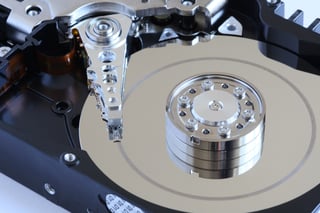Could you please tell me solutions to recover the data on this disk more efficiently and faster?
Send it in for service.
This is not a DIY fix. Software will not get around a physical issue like this. (IMO) One or more of the drive heads have failed and no matter how much time you allocate or fixes you try to apply, it won’t have any effect.
When you send it in, your drive will be disassembled and either the platters put into an enclosure with a good controller and good heads or known good heads will be swapped into yours. The data will be extracted, saved on a new medium and returned to you.
This is the only way to recover data from a drive that suffered a physical failure.
Drive Components…
There are 3 main components to a hard disk drive. Below is an image of a typical spinning drive showing the read/write head and the platter. Let’s look at the main components and possible symptoms:

Controller board. This interfaces the drive with the computer (USB). All data, commands, diagnostics, etc. to/from the drive goes through this board.
If the controller board was bad, nothing would work; it’s an all or nothing type deal. The fact that the drive is recognized (correctly), you can send read/write commands and even recover data means this board is working.
Disk Platters. Think of these as analogous to vinyl records except they are spinning metal disks that hold magnetic data.
Platters fail, but not completely. An area of the drive might become defective where it can no longer reliably hold a consistent magnetic charge resulting in data corruption. However, it’s highly unlikely that the whole platter becomes corrupt. It’s like a scratch on a record. Even a bad scratch across the diameter make the record unusable, the recorded music on the good parts is still accessible.
Drive heads (read/write). These are analogous to the pickup stylus and arm of a record player except instead of physically contacting the disk, they “float” over the medium and never make contact.
This is the most likely issue you’re experiencing
If the head(s) become corrupt, the drive will not be able to reliably read/write data across the entire drive. Just like a stylus on a record player, if you have a pristine (vinyl) record but a bad pickup head, no matter how many times you try to play the record, it will sound horrible regardless of how many times you try.
Increasing Speed…
Also how to increase write and read speed of my M2 macbook pro?
This is a moot point.
The drive (controller) will attempt to re-read the data until it passes the error-check. The drive is going to read the data as fast as it’s physically capable but it won’t move forward until the data is correct or it gives up.
This is not a function of the operating system or a different interface. Just like the record player example above, you won’t be able to speed up or increase the quality of the recording if what is coming out of the record player is noise. In this case, if the head (stylus) is failing and sending garbage from the recording, there’s nothing you can do until you fix that component.
Is Data Recovery worth it?
This is a case study in the value of having a backup; data recovery can be an expensive proposition. The cost calculation becomes the question “how valuable is your data worth to you?” That will determine whether or not the cost is “worth it.”
Backups are cheap!
The issue is not if your drive will fail, it’s when it will fail. Having a current backup allows you to recover from a failure quickly with little or no risk to your data. The cost for a second drive is far less than the time, effort, and eventual financial costs of a recovery service.
See these posts for additional details on backup strategies:

